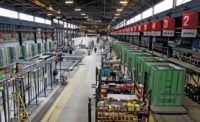Mechanical contractor J.C. Cannistraro has long focused on Lean Construction methods, high-tech tools, offsite construction and expansion of its services to give it a leg up in its market sector.
The Watertown, Mass.-based mechanical contractor’s strong bottom line stems from the staying power of Boston’s strong post-recession rebound and is a credit to the area’s economic diversity, says John Cannistraro Jr., president, who leads the firm with brothers David, the CEO, and Joseph, the chief financial officer.
ENR New England’s first Specialty Contractor of the Year, Cannistraro ranked 86th on the ENR’s 2017 Top 600 Specialty Contractors and second in last year’s first ranking of New England specialty contractors. This year, it is fourth in the region with $222 million in revenue.
Two of Cannistraro’s major projects are the 23-acre Seaport Square mixed-use development and the 22-story 88 Ames Street residential building. For the area, $500-million projects are “the new norm,” adds John. “That makes our portion of the projects larger too.”
Cannistraro has made strategic moves to enhance its capabilities, says John. The 2014 acquisition of local sheet-metal contractor Harrington Brothers Corp. has made Cannistraro able to offer clients “a fully integrated package,” he says. That advantage, plus an office and field staff of more than 800, “gives us a runway for continued growth,” John adds.
“We want new workers to be ready to step into what will be the way most construction is done in the future.”
– John Cannistraro Jr., President, J.C. Cannistraro
An early adopter of Lean Construction methods and technology-based construction practices, Cannistraro has more than 30 employees working in virtual design and construction across various disciplines. The firm has worked closely with software vendor Autodesk to streamline processes by incorporating manufacturing techniques. Among the innovations are modular equipment skids and mechanical penthouses, hospital headwall units and laboratories, all including mechanical, electrical and plumbing systems.
Jim Lynch, vice president of Autodesk’s construction products line, says Cannistraro sets “the bar on where the construction industry can go” using CAD/CAM and offsite construction to drive more predictable outcomes.
Calling Cannistraro’s embrace of technology and prefabrication “compelling,” Lynch adds that Autodesk has relied on the company’s feedback to gain a better understanding of the design-fabrication continuum. “You need a tight link between the software products to facilitate design changes, and [save] time,” Lynch explains.
To support its offsite operations, Cannistraro has refurbished a 157,000-sq-ft former U.S. Navy heavy machine shop in Boston’s Seaport District that opened last June. The shop allows fabrication of heating, ventilating and air-conditioning equipment, sheet-metal ductwork, piping for plumbing and sprinkler systems for fire suppression.
The facility allows the firm to expand offsite capabilities to meet an anticipated growth in demand for these methods that Cannistraro is known. For example, on a 500,000-sq-ft advanced patient care facility at Massachusetts General Hospital, led by Turner Construction Co., under an integrated-project-delivery contract, Cannistraro worked with electrical and drywall contractors. Cannistraro fabricated, assembled and tested headwall assemblies in the shop. The assemblies were then transported to the site and installed in a precisely timed sequence that helped minimize downtime and staging conflicts, according to Cannistraro.
Cannistraro’s commitment to coordination and leading-edge technology “allowed us to finish the mechanical level and primary heating and cooling services two months ahead of schedule,” says Brian Chase, Turner’s project executive.
While offsite construction has changed work in the field, not every subcontractor has followed Cannistraro’s VDC and offsite-construction lead. Though technology can help improve clash detection and preassembly, John considers “the inherent inefficiencies of construction” a persistent obstacle.
For that reason, the firm trains its field staff in offsite construction. “We push training at the apprentice level because they’re the foremen of the future,” John says.
With the average age of workers approaching 50, “we want new workers to be ready to step into what will be the way most construction is done in the future,” he adds. Performing offsite work can be appealing to new workers because it is considered safer to preassemble ceiling level units at waist height in a controlled environment rather than on ladders outdoors.
The statistics seem to bear out the safety plusses of offsite construction. Cannistraro’s recordable injury rate has dropped to less than 1.5 from 6. “That’s all a result of the culture change that these approaches have brought about,” John says.
The firm is also active in trade training programs for disadvantaged youth. Two of these are Building Pathways, which creates opportunities for residents of underserved communities, and Operation Exit, a reentry program for people leaving jail.
The firm also aided rebuilding efforts in Haiti after the earthquake and hurricane by prefabricating headwall assemblies and other components for new hospitals and shipping them to construction sites. Last year, after Hurricane Maria hit Puerto Rico, the specialty contractor not only conducted a campaign to raise money and gather supplies for victims of the storm, representatives personally delivered the goods to victims.
Even with its growth and focus on advancing construction, the brothers insist the firm’s principles remain close to those that guided their father when he established the business in 1963. David says he and his brothers “can relate to our employees as peers” because the brothers have personally worked in every labor position themselves. “We’re still a family business, and we love making things,” he says.
Cannistraro has worked on some of the largest projects in the Boston area:
Seaport Square: Cannistraro has been involved with several projects of this 23-acre mixed-use development underway in Boston’s Seaport District. Phase one included the mechanical infrastructure for buildings B and C, which have shops, residences and restaurants. The company is delivering HVAC piping, sheet metal and fire protection systems for a 928,000-sq-ft residential high-rise.
Harvard University – Science & Engineering Complex: The core and shell and tenant fit-out project involves a six-story, 640,000-sq-ft educational building in Boston’s Allston neighborhood that will be a laboratory and classroom building for Harvard University. Cannistraro is installing HVAC piping, ductwork and fire suppression systems on the project, which is scheduled to open for the 2020-21 academic year.
One Kendall Square – Buildings 600 and 700: Cannistraro provided HVAC piping, sheet metal, plumbing and fire protection systems to renovate laboratory and mechanical system upgrades for part of a 7.8-acre mixed-use complex in Cambridge, Mass.





Post a comment to this article
Report Abusive Comment